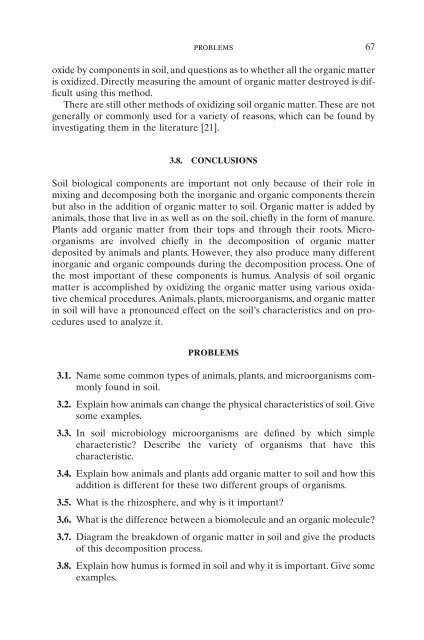Introduction to Soil Chemistry
Introduction to Soil Chemistry
Introduction to Soil Chemistry
Create successful ePaper yourself
Turn your PDF publications into a flip-book with our unique Google optimized e-Paper software.
problems 67<br />
oxide by components in soil, and questions as <strong>to</strong> whether all the organic matter<br />
is oxidized. Directly measuring the amount of organic matter destroyed is difficult<br />
using this method.<br />
There are still other methods of oxidizing soil organic matter. These are not<br />
generally or commonly used for a variety of reasons, which can be found by<br />
investigating them in the literature [21].<br />
3.8. CONCLUSIONS<br />
<strong>Soil</strong> biological components are important not only because of their role in<br />
mixing and decomposing both the inorganic and organic components therein<br />
but also in the addition of organic matter <strong>to</strong> soil. Organic matter is added by<br />
animals, those that live in as well as on the soil, chiefly in the form of manure.<br />
Plants add organic matter from their <strong>to</strong>ps and through their roots. Microorganisms<br />
are involved chiefly in the decomposition of organic matter<br />
deposited by animals and plants. However, they also produce many different<br />
inorganic and organic compounds during the decomposition process. One of<br />
the most important of these components is humus. Analysis of soil organic<br />
matter is accomplished by oxidizing the organic matter using various oxidative<br />
chemical procedures. Animals, plants, microorganisms, and organic matter<br />
in soil will have a pronounced effect on the soil’s characteristics and on procedures<br />
used <strong>to</strong> analyze it.<br />
PROBLEMS<br />
3.1. Name some common types of animals, plants, and microorganisms commonly<br />
found in soil.<br />
3.2. Explain how animals can change the physical characteristics of soil. Give<br />
some examples.<br />
3.3. In soil microbiology microorganisms are defined by which simple<br />
characteristic? Describe the variety of organisms that have this<br />
characteristic.<br />
3.4. Explain how animals and plants add organic matter <strong>to</strong> soil and how this<br />
addition is different for these two different groups of organisms.<br />
3.5. What is the rhizosphere, and why is it important?<br />
3.6. What is the difference between a biomolecule and an organic molecule?<br />
3.7. Diagram the breakdown of organic matter in soil and give the products<br />
of this decomposition process.<br />
3.8. Explain how humus is formed in soil and why it is important. Give some<br />
examples.
















